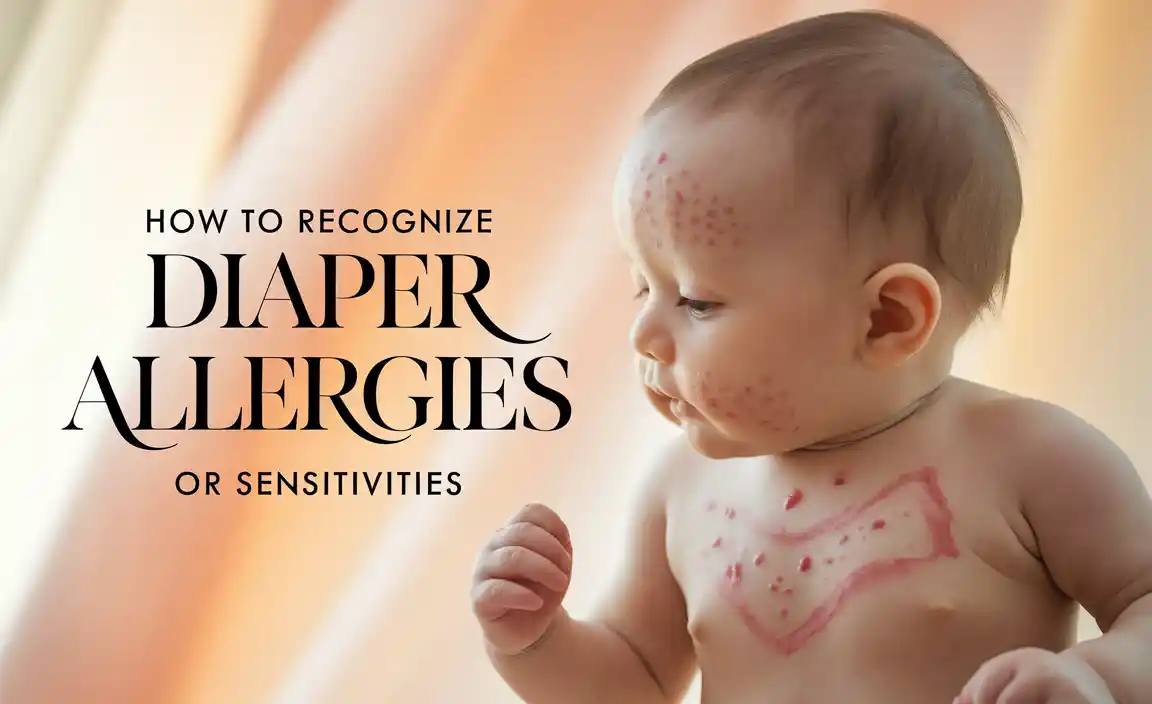Your baby’s skin is delicate and can be easily affected by the products you use on them. One of the babies’ most common skin irritations is diaper allergies or sensitivities. As a new parent, you are always highly alert regarding your baby’s health and well-being.
One of the most common challenges parents face is diaper rash or irritation. While this is a normal part of raising a baby, some babies may develop diaper allergies or sensitivities that require special attention. We will discuss recognizing diaper allergies or sensitivities.
We’ll get you covered, from differentiating, between diaper allergies and other skin conditions to discussing alternative diaper options for babies with allergies or sensitivities. We will also look at some important things to remember when using diapers and provide you with alternative diaper options suitable for babies with allergies or sensitivities. Read on to learn how to keep your baby’s skin healthy and comfortable.

5 Signs To Recognize Diaper Allergies Or Sensitivities
Diaper allergies or sensitivities are common for babies, but the signs can be difficult to recognize. A rash or eczema in the diaper region is one of the most common symptoms. Other symptoms include colic, vomiting, and bloody stools. Severe reactions, such as anaphylaxis and wheezing, are rare but can occur.
Parents should also look for nursing aversions, which suggest that babies may be experiencing discomfort or pain during feedings. In some cases, violent vomiting after feeding may indicate Food Protein Induced Enterocolitis (FPIES). Recognizing these signs and consulting a pediatrician for an accurate diagnosis and treatment plan is essential.
1. Persistent Diaper Rash
Persistent diaper rash can be a frustrating condition for parents to deal with, especially when it occurs regularly. It is important to recognize the early signs and symptoms of diaper rash so you can seek help and treatment as soon as possible.
Understanding the cause of the rash is also essential. Several factors, including poor hygiene, sensitive skin, or a specific allergen, can cause diaper rash. If the cause of your diaper rash is not easily identifiable, consider consulting a doctor to rule out any underlying conditions that could be causing your baby’s rash.
Suppose you suspect your baby is sensitive to a certain substance in their diapers, such as detergent or fabric softener. In that case, seeing if other options are available is important. Your doctor may recommend switching to disposable diapers or using natural detergents instead of synthetic ones.
Sometimes, you may need to modify your baby’s diet to address any food sensitivities contributing to their diaper rash. If nothing else helps, consider changing the type of diaper your baby wears.
2. Redness And Inflammation
Diaper rash is a common issue for many parents. It can be due to several factors, including allergies and sensitivities to specific materials in the diaper. Redness and inflammation are two of the most common types of diaper rash, and recognizing them can help you determine whether your child has a sensitivity or an allergy.
Redness in diaper rash is typically due to irritation from certain materials used in the diaper. This can include natural fibers like cotton, polyester, and wood pulp; synthetic fibers like polyester and microfiber; additives like dyes and perfumes; or other substances like detergents or cleansers.
Inflammation occurs when the skin becomes swollen and red because of irritation. This can be caused by soiled diapers needing more absorbent material or not often changing enough. In both cases, it’s important to reduce irritation and inflammation, such as changing diapers frequently or using cloth diapers rather than disposable ones, which can help reduce the number of irritating substances that reach your child’s bottom.
3. Blisters, Hives Or Welts
Blisters, hives or welts are three different types of allergic reactions that can occur on the skin due to contact with certain materials. These reactions can manifest as red, itchy bumps or blisters. Hives are commonly found on the neck or face. Diaper rash is a rash that looks like small red dots on the buttocks.
Blisters are painful and can lead to infection if not properly managed. Allergic reactions to disposable diapers and diaper liners are quite common in babies allergic to proteins in urine, feces, sweat, or saliva, leading to diaper rash. Allergic reactions may also be caused by detergents and softeners used in diaper manufacturing that cause skin irritation and inflammation.
For you to know if your child’s allergies are due to a sensitivity or an allergy to reusable diapers, you have to take into account a few factors, such as the age of your child when they were first exposed to a particular material, other people’s reports about their child’s allergies (if they use cloth diapers), and what symptoms your child has had when using reusable diapers.
4. Foul Odor
A foul odor from your baby’s diaper may indicate a potential diaper allergy or sensitivity. If the odor is particularly strong or persistent, it could indicate a more serious problem, such as infection or irritation. In these cases, you should seek medical attention to rule out any underlying conditions causing the issue.
Diaper allergies and sensitivities can vary in severity. Some babies may only experience mild irritation or rash. Others, however, may be much more sensitive and develop more severe symptoms such as severe rash and redness, severe itching, and severe respiratory issues.
If you notice a foul odor coming from your baby’s diaper, it is important to seek medical attention to check for any underlying conditions that could be causing the issue. These can include infections or injuries to the skin or rectal area caused by improper use of diapers.
5. Discomfort And Fussiness
A diaper rash is a common and troublesome condition for many babies and can be a source of great discomfort for both the baby and the parents. However, some other conditions can also cause diaper rash, including allergic reactions to certain materials in the diaper.
These reactions can be mild or severe and often difficult to recognize and treat. If you suspect your child has a diaper rash caused by an allergy, visiting a doctor as soon as possible is important. It may require special treatment with creams or ointments that contain less allergenic materials. In addition to relieving the discomfort of a diaper rash caused by an allergy, this treatment can often prevent long-term damage to your child’s skin.
Differentiating Between Diaper Allergies And Other Skin Conditions
Differentiating between diaper allergies and other skin conditions is crucial to accurately treating and preventing diaper rashes. Allergies occur when the immune system reacts to a particular substance, whereas other skin conditions can be due to various factors such as irritants or harsh cleansers.
One key factor in identifying a diaper allergy is the time it takes for symptoms to appear. Allergic-reaction diaper rashes usually take 7-21 days to show after the first exposure. Furthermore, it is essential to understand the difference between allergies and food intolerances.
Allergies generally require complete avoidance of the offending substance, whereas food intolerances may allow for a small amount of food without symptoms. Accurately identifying the allergen may require up to 28 days of observation and involve consulting a medical professional. Understanding the difference between diaper allergies and other skin conditions is the first step in ensuring proper treatment and prevention of diaper rashes.
Things To Keep In Mind When Using Diapers
When it comes to using diapers, there are a few things to keep in mind to prevent diaper rash and other allergic reactions. Firstly, changing diapers often and keeping the diaper area clean and dry is key. You can achieve this by using water wipes, gently patting with a cotton cloth, and applying diaper cream or ointment.
Cloth diaper users should follow the manufacturer’s instructions for cleaning and avoid using fabric softeners or dryer sheets. If your baby experiences an allergic reaction, it is crucial to establish healthy diaper habits and switch to different baby skincare products.
If your baby is sensitive to diaper wipes, use a soft washcloth moistened with plain water instead. In conclusion, paying attention to a baby’s skin reactions and providing a healthy diapering environment can go a long way in avoiding diaper allergies or sensitivities.
What Are Some Alternative Diaper Options For Babies With Allergies Or Sensitivities?
If your baby has diaper allergies or sensitivities, several alternative options exist. One is using hypoallergenic and unscented disposable diapers. Another option is cloth diapers that are free of dyes and perfumes. Applying ointments or creams can help protect the skin from further irritation.
It is also essential to look out for any food allergies or sensitivities causing the issue. Additionally, giving your baby periods without wearing a diaper and having frequent diaper changes is recommended.
This can help treat diaper dermatitis and prevent further irritation. However, it’s essential to consult your doctor or pediatrician for proper diagnosis and treatment of diaper allergies or sensitivities. They may also recommend some of the options or alternatives catering to your baby’s unique needs.
Conclusion
Recognizing diaper allergies or sensitivities can be quite challenging for new parents. Diaper allergies or sensitivities are common and can affect just about anyone. If you need to find out if you are sensitive to diapers, a few clues can help you identify the problem.
Remember that diaper allergies do not always appear immediately after wearing diapers; sometimes, they can take weeks or even months to develop. Paying attention to your baby’s skin and bathroom behaviors can indicate the need to switch to different diaper options that cater to their needs.
It’s crucial to differentiate diaper allergies from other skin conditions and to keep in mind certain factors, such as the material of the diaper and the baby’s skin type. Seeing a doctor for proper diagnosis and advice is also recommended.
If you suspect your baby has a diaper allergy, consider alternative diaper options or consult a medical professional. Regular diaper changes, gentle cleaning, and using products with natural ingredients can help prevent and alleviate diaper rashes. When in doubt, consult your pediatrician.
Frequently Asked Questions:
[rank_math_rich_snippet id=”s-04d69089-f742-4d50-bec6-e7d752b2ed7a”]







